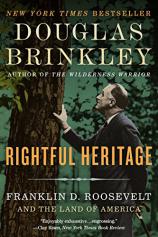Rightful Heritage: Franklin D. Roosevelt and the Land of America
Review
Rightful Heritage: Franklin D. Roosevelt and the Land of America
This impressively researched book is part of a projected trilogy, and a sequel to THE WILDERNESS WARRIOR, about Teddy Roosevelt’s crusade to preserve America’s natural resources. In an interview about that first volume in BookPage, Brinkley told Edward Morris, “In many ways, the conservation story is a triumphal American story, but it’s also filled with warnings about the things we’re not doing properly now.”
That seems to be at the heart of Brinkley’s efforts to chronicle Teddy’s and now FDR’s efforts to protect the land: they succeeded in much of what they accomplished --- and Brinkley notes that several subsequent presidents, including Kennedy, Johnson, Nixon, Carter, Clinton and Obama, have continued those efforts --- but there’s more to be done.
"What is particularly winning about RIGHTFUL HERITAGE is that it is about remarkable feats, often done because they should be done, not simply for political expediency."
With so many books on FDR’s remarkable accomplishments, reading a hefty book that is almost exclusively about his efforts to preserve land, marine life, birds and endangered species makes for odd juxtapositions. Pearl Harbor gets a mere paragraph before the focus turns to Executive Order 8979, to protect Alaska’s Kenai Peninsula. Brinkley notes that on D-Day, FDR received the deed to what would become Big Bend National Park. He focuses on the war’s impact on FDR’s conservation plans, forcing him to defund the Civilian Conservation Corps (CCC), close down the Works Progress Administration (WPA) and backtrack on his strict waterfowl protection policy.
One could --- and perhaps should --- argue that there are plenty of books about every aspect of FDR’s long presidency, but none that so exhaustively covers his devotion to conservation. And there’s no question that FDR believed in environmental efforts, telling his Secretary of State, Cordell Hull, to make sure that conservation was on the agenda at the Dunbarton Oaks conference in 1944: “I am more and more convinced that conservation is the basis of permanent peace,” he wrote in a memo to Hull.
Brinkley credits Roosevelt’s love of the outdoors to his early years in the Hudson River Valley, where he was an only child roaming around the grounds of his family home in Hyde Park. Describing how much the natural world meant to him, Brinkley writes this about FDR in his 20s: “Even though Franklin was in Manhattan for most of that period (1907-1910), taking classes at Columbia and then practicing law, his interest in conifers…intensified.” From his earliest years as a senator, Roosevelt promoted conservation, starting with the Roosevelt-Jones Conservation bill of 1912.
But, of course, coming into office during the Depression allowed President Roosevelt to accomplish some of his most memorable conservation efforts, from the creation of the CCC (which put 3.4 million men to work), to the expansion of the National Park Service (celebrating its centenary this year) and the preservation of multiple parks, including the Everglades and Joshua Tree. (He also created the Tennessee Valley Authority [TVA] and generally supported hydroelectric dams, though Brinkley notes that “History proved Roosevelt was shortsighted about the ecological damage these dams caused.”)
What is particularly winning about RIGHTFUL HERITAGE is that it is about remarkable feats, often done because they should be done, not simply for political expediency. FDR and cousin Teddy understood as well as today’s environmentalists that there are often no second chances to save the wilderness from commercial use. Armed with that knowledge, Roosevelt preserved millions of acres of land and shoreline, for the enjoyment of generations of Americans to come.
Reviewed by Lorraine W. Shanley on March 17, 2016
Rightful Heritage: Franklin D. Roosevelt and the Land of America
- Publication Date: March 14, 2017
- Genres: History, Nonfiction
- Paperback: 784 pages
- Publisher: Harper Perennial
- ISBN-10: 0062089250
- ISBN-13: 9780062089250





